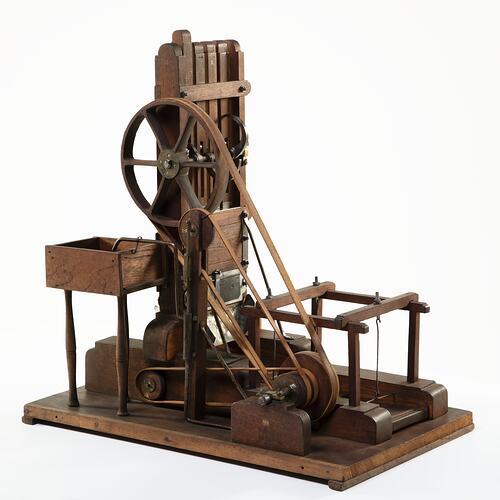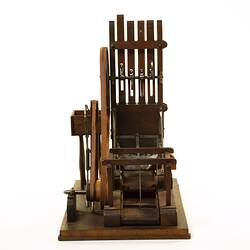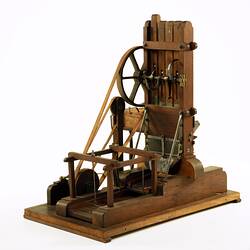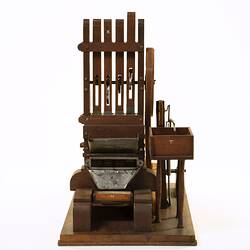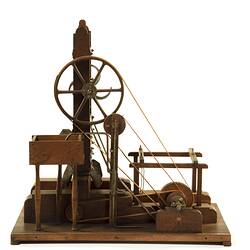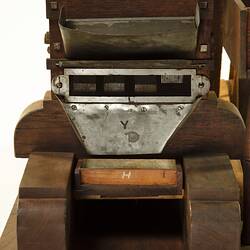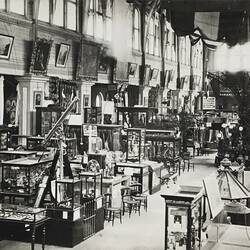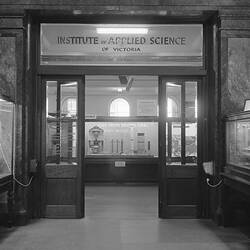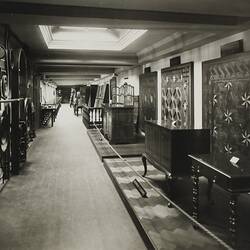Summary
Watson's stamp battery. Four wooden stamps and percussion table. Of a type used for the processing of quartz ores to extract gold at Bendigo (Sandhurst), during the 1850s. Scale 1:12.
This model, built by the John Watson of Bendigo, depicts the first stamp battery in Victoria to successfully extract gold by crushing quartz ore. Messrs. Latham & Watson of Bendigo constructed the first successful stamping machine in Victoria.
The design has similarities to the Application for Victorian Patent No.14, lodged by Thomas Hustler, of Sandhurst (Iron Bark Gulley [sic], Bendigo), on 11th December 1854, being for an "Instrument, Machine or Engine, for the purpose of crushing quartz and all other Auriferous Rocks", by means of stampers.
After being shown at the Sandhurst (Bendigo) Exhibition of 1854, it was presented to Frederick McCoy, founding director of the National Museum of Victoria. In 1871, it became one of the first exhibits to go on display at the new Industrial and Technological Museum in Melbourne.
John Watson was born in December 1822, at Galgate, Lancashire, a smalltown within a few miles of the City of Lancaster. He came from a family of practical engineers, and was himself trained in the profession prior to emigrating. Departing Liverpool on 5th December 1851, on the sailing ship 'Gibson Craig', of 1201 tons, under the command of W.H. Ellis, he arrived at Melbourne on the 13th March 1852. His shipmates on the voyage included fellow Yorkshiremen, Jonathan Latham, who became a lifelong business partner and William Caldwell, a blacksmith who later worked for the pair for many decades residing near their mining claim on Hustler's Reef. Forming a partnership John Watson and Jonathan Latham initially spent 9 months engaged in alluvial mining enterprises at Maiden Gully, near White Hills, and later on the Ovens goldfield, before opening a store near White Hills in early 1853, in partnership with a Mr Horseman. This enterprise was so successful that within 12 months the partners had opened additional branches throughout Bendigo and on the McIvor Diggings (at Heathcote). In January 1854, Messrs Latham and Thomas Hustler purchased a promising quartz claim at Ironbark, situated on the formation later known as Hustler's Reef. After initial difficulties in extracting and saving gold from the quartz ore, they turned to John Watson, who was offered a share in the mining claim in exchange for his professional engineering expertise. He build the partners' first successful quartz crushing machine, which was in operation by December 1854. Thomas Hustler retired from the partnership in December 1856, which was then continued by Latham & Watson, being developed into one of Bendigo's most successful early quartz mines.
During the 1870s, John Watson was involved in the early development of Victorian black coal resources at Kilcunda, Gippsland, as a director of the Western Port Coal Mining Co., losing a significant portion of his personal fortune on the enterprise. Later he superintended operations of the Government's diamond drill in the further exploration of coal seams in the district. He died on Saturday 14th December 1882, at his home on Hustler's Reef.
Physical Description
Wooden model with large wheel and metal cams at top of upright section joined by leather straps to horizontal section with chute. Four wooden stamps and percussion table.
More Information
-
Collecting Areas
-
Acquisition Information
Donation & Subsequent Transfer from National Museum of Victoria, Latham & Watson (Messrs), 1871
-
Modelmaker
Mr John Watson, Ironbark Gully, Sandhurst (Bendigo), Victoria, Australia, circa 1854
-
Organisation Named
-
Inscriptions
Parts of model labelled: "A"; "E"; "H"; "L"; "P"; "R"; "S"; "T"; "V"; "X"; and "Y".
-
Classification
Mining & metallurgy, Ore crushing - gold, Model stamp batteries
-
Category
-
Discipline
-
Type of item
-
Object Dimensions
605 mm (Length), 372 mm (Width), 640 mm (Height)
-
References
'Death of Mr. John Watson', Bendigo Advertiser, 16 Oct 1882, p.3, from [Link 1] ; 'First Mine Engine', The Australasian (Melbourne), 23 May 1931, p.4, from [Link 2] ; I. & T. Museum catalogue no. 3362 (1873). National Museum Catalogue of Min., Met., Geol. & Agri. Models, p.xi, no. 5838; See also file for description of mechanism.
-
Keywords
